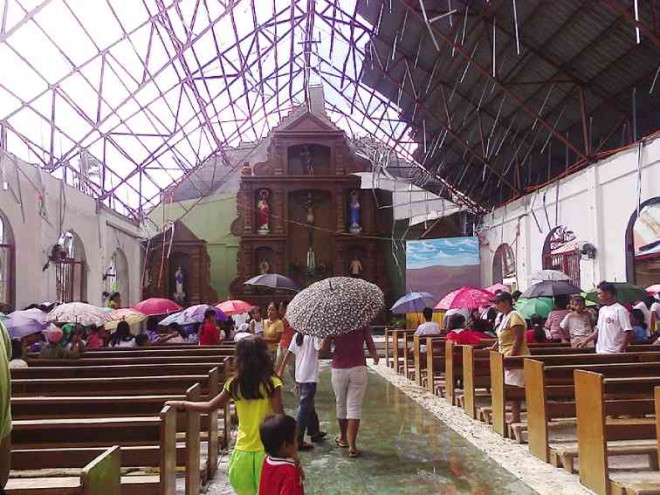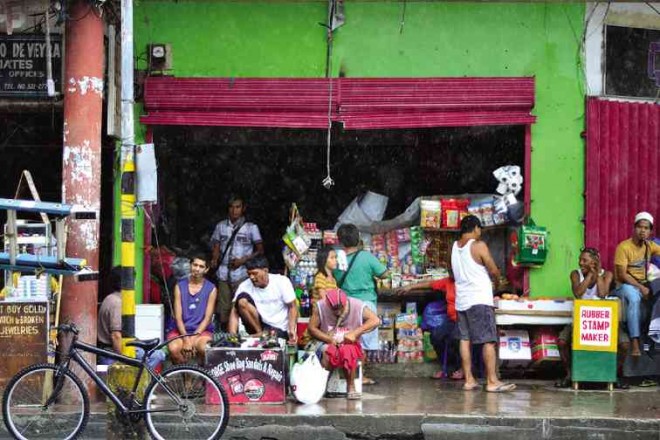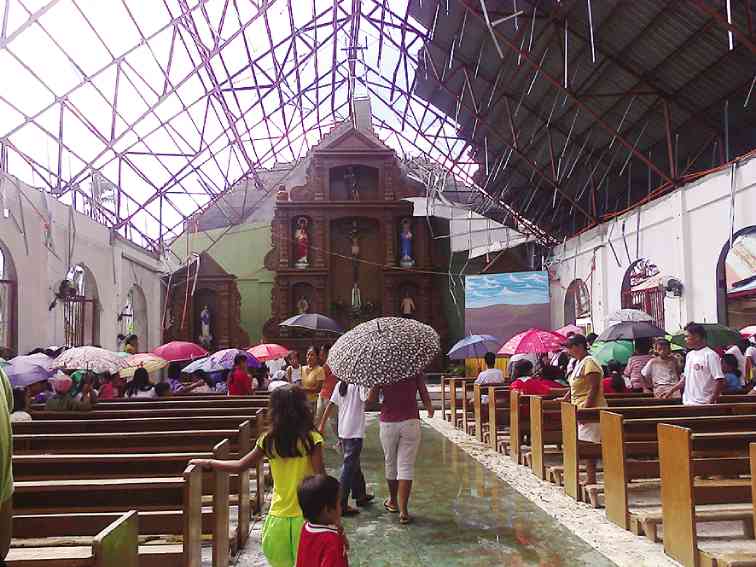
“Yolanda” survivors beseech the heavens with prayers. MOZART PASTRANO
TACLOBAN CITY—The Papal Nuncio, Giuseppe Pinto, has sent word that he is spending Christmas here. Archbishop John Forrosuelo Du, DD, is moving heaven and earth to ensure that the dignitary will have a decent room at the Archbishop’s Residence during his visit.
On top of a hill off the highway, the Archbishop’s Residence is now like the rest of the landscape: in ruins. Its roof had flown off, its windows broken, some of its walls knocked down, and an entire portion of the upper floor obliterated. It looks like it had been ravaged by war.
The handful of priests who continue to stay there are camped in one room. In lieu of beds, they crawl into little tents crammed in a tiny room in the badly battered structure on the second floor, near a toilet and bath which are no longer in working condition.
“Our chapel had a panoramic view of the lay of the land,” the archbishop told us as he gave us a command tour of his official domicile. When he pointed out where the second-story chapel was, we saw only a heap of rubble.
He said it took weeks of rummaging through all that debris to find the Blessed Sacrament. The crucified Christ had apparently swooped down, wooden cross and all, to safeguard it against His chest before everything else collapsed.
Now the Blessed Sacrament, unscathed and resplendent in its glorious golden design, is ensconced in a place of honor in the chapel on the first floor, where water comes through what’s left of the ceiling whenever it rains.
The Archbishop’s Residence is outside the city, 15 minutes’ drive south on the lower lip of the Leyte Gulf, in what used to be the teeming port town of Palo (pronounced with the accent on the second syllable).
Archbishop Du is known as the Archbishop of Palo, under whose jurisdiction the faithful of Tacloban belong to (including the rest of Leyte as well as Calbayog, Borongan, Catarman and Naval). The cheerfully cherubic Cebuano was installed in his current position last year.
And now he is quick, if not sad, to report, “70 of the 76 churches in the archdiocese have been damaged.”
Daily routine
On the day the strongest typhoon to ever make landfall arrived here, Archbishop Du woke up at four in the morning, as usual. He was aware that “Yolanda” was on its way, but observing that there was nothing calamitous about the weather at the time, he decided to follow his daily routine.
He left his hilltop residence and, following the course of what looks like a creek but the locals call a river, went to the cathedral in the heart of town, where the archdiocese takes pride in its 8-hectare spread housing assorted seminaries, including a high school seminary, and various other religious offices and centers.
In the cathedral, he first led the faithful in praying the rosary. Then he celebrated the early morning Mass.
As the Eucharistic celebration was wrapping up, the wind began to pick up. He blessed the 500 parishioners in attendance and ended the Mass. When it became clear that the cathedral was no place of refuge from the tempest, he led them in search of safe haven.
They went from building to building in the archdiocesan complex, but the roofing kept on being yanked away and the water kept coming at them. The beleaguered Mass-goers took a last stand by clinging to the trusses of an ongoing construction at the complex.
There, they saw everything being swept away by the torrential wind and water, and they held on with all their strength and all their prayers. People they knew flew past them, screaming for help, but they themselves were doing all they could to withstand the end of the world as they knew it.
Thankfully, the high school seminarians were away on an out-of-town trip. The college seminarians saved themselves in the nick of time by plunging into the flash flood and swimming to another building.
“It went on for three hours,” Archbishop Du recalled. “Thank God, we were saved.”
Two priests in the archdiocese were eventually included in the body count.
Relief caravan
Archbishop Antonio Ledesma of the Archdiocese of Cagayan de Oro blessed 150 volunteers at the end of a late afternoon Mass at Rodelsa Circle beside the Cagayan de Oro River a few days ago. This was the Mass commemorating the second anniversary of Typhoon “Sendong” which devastated the capital city of Northern Mindanao on Dec. 16, 2011.
Organized by Eileen Escobar-San Juan, who led tourism and investment programs in Cagayan de Oro under the administration of Mayor Oscar Moreno, the Sendong commemoration—“Beyond Sendong: Rebuilding Lives and the City”—was highlighted by the send-off of volunteers from Cagayan de Oro to provide Christmas cheer for survivors in Tacloban City.
The operation, called “Remembering Sendong, Caring for Yolanda,” had a caravan of vehicles passing the Maharlika Highway from Cagayan de Oro through Butuan City to Surigao City

in northeasternmost Mindanao, and then hopping on barges to the southernmost tip of Leyte.
This initiative was a brainchild of Xavier University’s vice president for research and social orientation, Dr. Hilly Roa-Quiaoit, upon the encouragement of XU president Fr. Roberto Yap, SJ.
Tranquil scene
Upon reaching the new port of San Ricardo in Southern Leyte, we were shocked by the sparkling beauty of the place: the clear blue sea lapping the verdant shore, with some locals stripping to their shorts as they made waves in the nonetheless tranquil scene.
This was no typhoon disaster area, we thought, until we saw two truckloads of hogs and large covered trucks marked “World Food Programme” coming out of the barge with us.
The horror began to unfold: villages and beach resorts and entire towns stripped to their skeletal remains. Some houses looked like sets in a high-budget theater production: the fourth wall peeled off, allowing us to witness up close the drama of everyday life—a dining room twinkling with Christmas lights, a bedroom partitioned by layers of mosquito nets, children watching TV. A car teetered on a wall beside the road. A staircase led up to nowhere.
Wasteland
Finally, we arrived in Tacloban. Tricycles and jeepneys now ply the city streets, but wherever you go you feel you are in the midst of a wasteland.
There is no escape from the stench.
At the Sto. Niño Church, where Imelda Marcos used to hear Mass and where the priests continue to say Mass even though the floor is continually flooded because the ceiling has given way, there are notices by the main entrance marked “Missing,” which cue you on some of the disappeared.
We were at first directed to stay in what used to be called the Divine Word University, but which is now named Liceo de Verbo Divino.
Said to be something like the Ateneo of Tacloban, it is in shambles and looks abandoned, but, in fact, has become the headquarters of the Gawad Kalinga operations headed by the efficient and personable Patrick Doromal.
We ended up at the Holy Infant College run by the Religious Sisters of Mercy. The only structures with the roof still in place are the convent and the covered court. Our field operations manager, Peanuts Uy, led the way in setting up sleeping quarters at the covered court.
Police presence
On our first day, we went around town. Rizal Avenue, Tacloban’s main business district, is alive with holiday shoppers.
Ukay-ukay shops line up Zamora Street, where one can find Primhouse Hotel. Locals say this got fully booked immediately after Yolanda hit Tacloban.
In one corner, local vendors sell binagol and moron, Leyte’s famous delicacies, though at a relatively higher price. Prices of local products have gone up as the coconut industry has been badly hit.
International and national food chains are still closed. But a good sign that Tacloban is bouncing back is the opening of a chicken-specialty store. And there is buzz about the grand launch of Robinsons Tacloban before Christmas Day.
Interesting sight
An interesting sight is the proliferation of electric power-charging stations. Enterprising Warays are banking on the Filipinos’ need for connection, thus all the load centers and charging stations.
Several travel agencies have reopened shop. The city’s well-known museum has reopened. And the fallen statue in the MacArthur Memorial is back in place.
Near the Liceo is Welcome Pensionne and Hotel Consuelo. The former caters to local tourists, while the latter has World Food Programme workers and staff as regular clients.
A most popular hangout is Stephanie Smoke House, just in front of the campus of Liceo. Here, a combo meal of fish (grilled tuna belly) or meat viand (humba, beef steak, chicken curry) and vegetables, with unlimited rice, costs between P150 and P200. Your P50 can buy you instant coffee or Coke.
I noted a lot of foreigners and balikbayan doing the Good Samaritan bit, just like us. My good friend Imma Kaamino, from Oroquieta City and now based in Cebu City, celebrated her birthday on Dec. 8 by coming over with family and friends to distribute mats and blankets and underwear. She also was open to the possibility of adopting an orphan.
Psychosocial interventions
The parish priest of the Parish of San Roque in Barangay Patoc in the town of Dagame in Leyte, almost an hour’s drive from Tacloban City, is the hefty and hospitable Reverend Fr. Erby Davy Lajara. He has put up a Christmas tree made of dried castaway coconut fiber, and placed this installation art outside the parish church.
Which is just as well, because the church has no more roof, and parishioners bring their umbrellas inside the church when they hear Mass.
Father Lajara busied himself checking out the faithful from 16 barangays gathered on his parish grounds when we visited.
“This was the first time they underwent psychosocial interventions,” he said.
Children and the youth had play therapy, while the adults were huddled in groups for debriefing sessions.
At first, the adults grudgingly went along. Having traveled all the way from their remote barangays early in the morning, all they wanted was to get the relief goods and go home. But as they went through the sessions, they slowly opened up, confiding their fears and concerns.
More beneficial
They admitted that the onset of rain these days was enough to frighten them. They said they are worried about reports that flesh-eating natives—some of them called these natives “Badjaos,” others, “Aetas”—are roaming their area.
Some adults in the debriefing sessions talked about the jailbreaks in the wake of Yolanda, and they ticked off reports about break-ins and rapes.
Some claimed they are busy looking for jobs elsewhere, pointing out that the season of relief goods would come to an end. A number suggested that instead of canned goods, it would be more beneficial to receive seedlings of vegetables or other cash crops.
Local residents were also taught how to set up waterless toilets called UDDT. Outside the parish grounds, children were running in the dusty streets flying their homemade kites.
“Many of them survived the strong winds of Yolanda by going out into the field and lying on the ground,” said Father Lajara.
Psychosocial intervention facilitator Roger Lee, of XU’s psychology department, was so moved by the parishioners’ strong sense of moving on. “And to think they lost their homes,” he said.
“We the survivors of Typhoon Sendong are reaching out to our brothers and sisters who have survived Supertyphoon Yolanda so that we will all share lessons and insights,” said Engr. Ermin Stan Pimentel. “What a meaningful Christmas.”
And with that, he began to plan the next day’s activities. With additional reporting by Evans Yonson









































